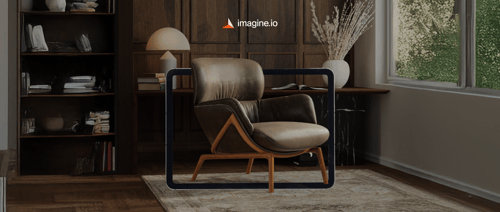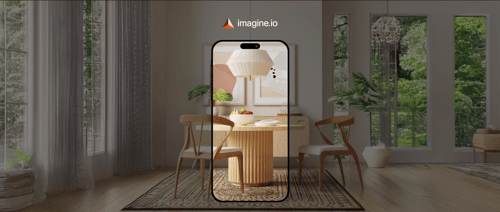Quick Listen:
Imagine scrolling through an online furniture catalog, captivated by a velvet armchair that seems to glow under perfect lighting, its texture so vivid you can almost touch it. You'd swear it's a photograph, but it's not. It's a photorealistic 3D rendering a digital creation so lifelike it's reshaping how we shop for furniture. This isn't just a trend; it's a seismic shift in e-commerce, where virtual products feel as real as those in a showroom, blurring the boundaries between the digital and physical worlds.
Photorealistic rendering technology is transforming online furniture catalogs, and companies like imagine.io, a trailblazer in 3D visualization and augmented reality (AR), are leading the charge. These aren't mere images; they're powerful tools that boost customer engagement, streamline sales, and revolutionize how furniture is designed, marketed, and sold. As online shopping surges, photorealistic renders are becoming the cornerstone of a retail experience that's immersive, efficient, and visually spectacular. Here's how this technology is redefining the industry and why it matters.
The Technology Powering the Revolution
At its heart, 3D rendering converts digital models into stunning 2D images or videos using sophisticated graphics. Once confined to gaming and film, this technology now thrives in architecture, product design, and furniture retail. According to a November 2024 industry analysis, the global 3D rendering market, valued at $5.36 billion in 2025, is projected to skyrocket to $23.78 billion by 2034, with an impressive 18% CAGR. The reason? Renders now achieve such precise textures, lighting, and detail that they rival professional photography.
Furniture brands are embracing this technology with enthusiasm. Rather than shipping products to costly photo studios, manufacturers collaborate with visualization studios to craft digital twin furniture virtual replicas that can be endlessly customized. Change the upholstery, tweak the lighting, or place the piece in a new setting, all with a few clicks. These renders aren't just visually striking; they're practical, providing manufacturers with detailed visual guides to streamline production before crafting begins.
The real magic, though, lies in customer experience. Shoppers today demand more than static images; they want immersion. Photorealistic renders, especially when paired with AR, create virtual showrooms where customers can visualize furniture in their own homes, ensuring it complements their space. This trend aligns with the booming catalog market, which stood at $2.38 billion in 2024 and is expected to reach $3.39 billion by 2034, driven by e-commerce growth and innovations like AR and VR.
Success Stories in the Real World
The impact is undeniable. Major retailers like Wayfair and IKEA have long used 3D renders to power their online catalogs, offering customers visuals so detailed they rival in-person shopping. Some brands take it further, integrating AR to let shoppers project furniture into their living spaces before buying. The payoff? Higher sales, fewer returns, and more satisfied customers.
Consider a mid-sized furniture retailer that adopted photorealistic renders. The result was a significant increase in online sales and a notable reduction in returns. Why? Customers had a precise understanding of what they were purchasing, thanks to renders that captured every angle, texture, and hue with remarkable accuracy. This clarity eliminates the uncertainty that often leads to returns. Another brand leveraging AR-powered renders found that shoppers spent more time on their site, engaging with interactive “try-before-you-buy” features that make shopping feel personal and intuitive.
E-commerce platforms are amplifying this trend, weaving photorealistic renders into online catalogs alongside interactive tools. These platforms don't just sell furniture; they craft narratives, helping customers envision how a piece fits into their lives. By blending cutting-edge visuals with seamless functionality, they're setting a new standard for online retail.
Navigating the Challenges
Yet, the path to photorealism isn't without obstacles. Creating these renders requires significant resources: powerful computers, advanced software, and skilled 3D artists. For smaller brands, the initial investment can be a barrier. Scaling production poses another challenge. Ensuring consistent quality across a vast catalog of products demands precision, and a single misstep like an inaccurate color or texture can undermine credibility.
Trust is perhaps the biggest hurdle. Shoppers are discerning, and many have been disappointed by products that don't match their online images colors that fade in person or materials that feel less premium than promised. While photorealistic renders are stunning, they can heighten skepticism if they seem too flawless. Customers may wonder, “Will the real thing live up to this?” Inaccuracies in lighting or texture can lead to misrepresentation, making it critical for brands to prioritize authenticity over embellishment.
Why the Investment Pays Off
Despite these challenges, the rewards are transformative. Photorealistic renders empower customers with a clear, comprehensive view of a product's quality and aesthetics, fostering confidence in their purchases. When shoppers can explore a piece from every angle in lifelike detail, they're less likely to return it a significant advantage for retailers grappling with the multibillion-dollar cost of returns.
Cost savings are another compelling benefit. Traditional photoshoots are resource-intensive, requiring physical products, studios, and teams of photographers and stylists. A single shoot can cost thousands, and any product update means starting over. Renders, by contrast, are agile. Need a new fabric or background? It's a quick digital tweak, not a logistical overhaul. This flexibility allows brands to keep their catalogs dynamic and cost-effective.
For furniture companies, renders are a strategic differentiator. In a competitive market, offering state-of-the-art visuals especially with AR or virtual showrooms sets a brand apart. It's not just about selling a table or chair; it's about delivering an experience that feels modern, interactive, and tailored. This approach resonates with tech-savvy consumers and builds loyalty in a crowded digital landscape.
The Future of Furniture E-Commerce
What lies ahead? The trajectory of photorealistic renders in furniture e-commerce is exhilarating. As rendering technology evolves, visuals will become even more lifelike, with real-time rendering poised to become standard. Imagine browsing a catalog where products load instantly in breathtaking detail, ready to be placed in your virtual space. Virtual reality (VR) could push the boundaries further, enabling customers to “walk” through digital showrooms from the comfort of home.
Industry experts see AR and VR as the next frontier, transforming shopping into an engaging, even playful experience. Brands that adopt these technologies early will gain a competitive edge, cultivating loyalty among consumers who value innovation. For retailers hesitant to invest, the advice is straightforward: start modestly. Experiment with a handful of high-quality renders, integrate AR features, and track the results. The data speaks for itself customers are drawn to these tools.
The influence of photorealistic renders extends beyond furniture, reshaping e-commerce across sectors like fashion, electronics, and more. They demonstrate that technology, when executed thoughtfully, doesn't just address challenges it unlocks new opportunities. The next time you're captivated by a piece in an online catalog, wondering if it's too perfect to be real, consider this: the image may be digital, but the transformation it represents is profoundly tangible, heralding a new era of online shopping.
Disclaimer: The above helpful resources content contains personal opinions and experiences. The information provided is for general knowledge and does not constitute professional advice.
You may also be interested in: CGI Projects with 3D Rendering - imagine.io
Struggling with expensive, outdated product visuals that slow down your creative process and stunt eCommerce growth? imagine.io's AI-powered platform empowers furniture, home décor, and textile brands to effortlessly produce striking 3D images, immersive videos, AR experiences, and interactive configurators. Cut production costs up to 70%, boost conversions 5X, speed up prototyping, and supercharge your online sales. Ready to elevate your product visuals and captivate customers? Book a demo with imagine.io today!
Powered by flareAI.co




.png?width=500&name=How%20to%20Add%20a%203D%20Product%20Configurator%20to%20Your%20WordPress%20Website%20(Complete%20B2B%20Guide).png)
















%20(1).png?width=500&name=Why%20Exploded%20Mattress%20Views%20Matter%20(And%20How%20to%20Generate%20Them)%20(1).png)
.png?width=500&name=Best%20Shopify%20Product%20Configurator_%20How%20to%20Choose%20the%20Right%20One%20(2).png)
.png?width=500&name=Why%20Exploded%20Mattress%20Views%20Matter%20(And%20How%20to%20Generate%20Them).png)



.png?width=500&name=Best%20Shopify%20Product%20Configurator_%20How%20to%20Choose%20the%20Right%20One%20(1).png)







.png?width=500&name=How%203D%20Rendering%20Can%20Make%20or%20Break%20Your%20Industrial%20Design%20Pitch%20(1).png)








%20with%20Digital%20Twins%20and%203D%20Visualization.png?width=500&name=Optimizing%20Your%20Digital%20Asset%20Management%20(DAM)%20with%20Digital%20Twins%20and%203D%20Visualization.png)




.png?width=500&name=Styling%20Home%20Decor%20for%202025_%20From%20Global%20Influences%20to%20Playful%20Personalization%20(1).png)
